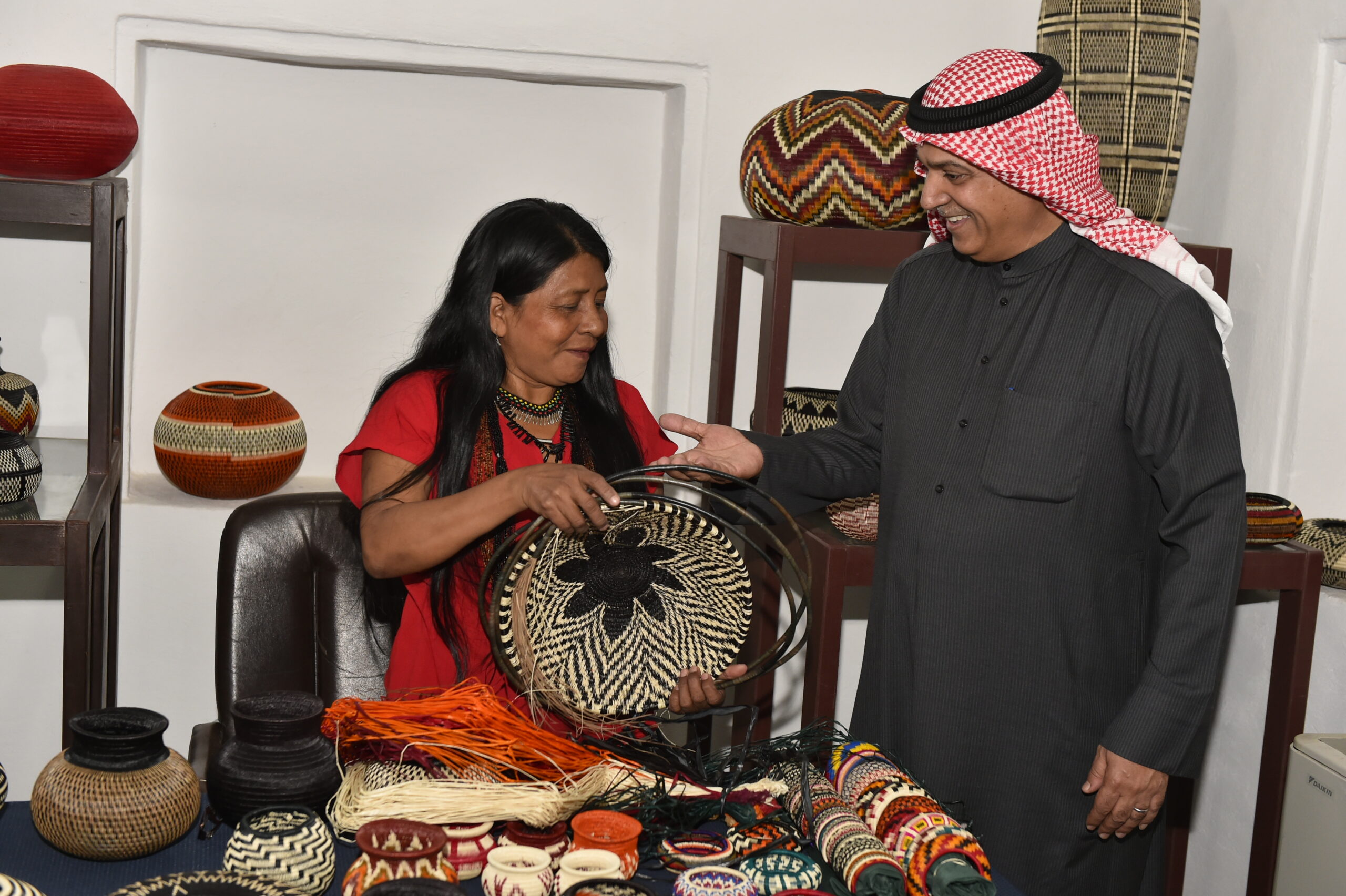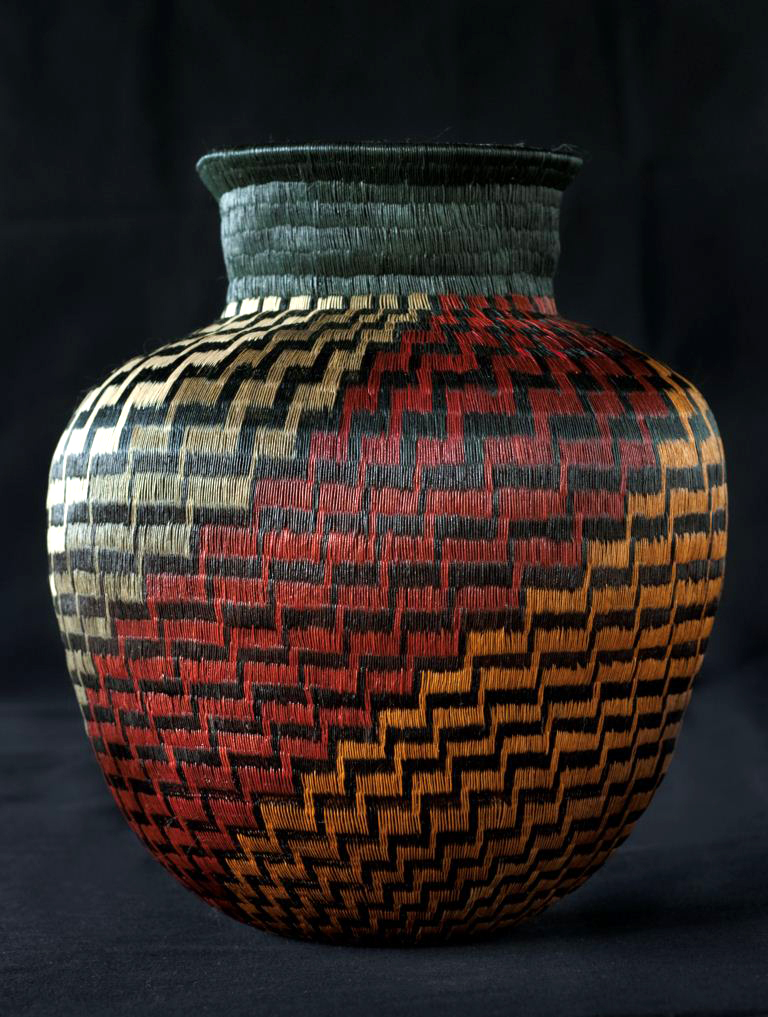Description
En la costa pacífica al sur del departamento del Choco, a orillas del bajo San Juan está localizada la comunidad indígena wounaan, una de las zonas más lluviosas de Colombia; allí se elaboran unos de los más bellos canastos que se producen en el país.
Las mujeres se dedican al oficio de la cestería, utilizando la palma del Werregue, que se obtiene de la palma del mismo nombre; crece entre manglares y alcanza hasta veinte metros de alto. Anteriormente los hombres talaban la palma, hoy en día con ayuda de media luna, obtienen el cogollo y las hojas sin derribarla.
Las mujeres procesan las hojas cortándolas y separándolas en tiras que convierten en hilos para el tejido, estos se cocinan para aumentar su maleabilidad y agregar tintes vegetales que dan los característicos colores negro, naranja y amarillo, entre otros.
El negro se obtiene mediante un proceso de inmersión en barro; el amarillo con semillas de bija o achiote y el anaranjado con azafrán.
Se dejan secar al sol y luego se empieza la construcción del canasto de la base hacia arriba. La base se teje en espiral enrollando los hilos flexibles sobre un alma, generalmente de iraca, que sirve de estructura para formar el canasto, los hilos se van cosiendo con aguja.
Los diseños reflejan la cosmovisión de la comunidad que plasman en formas geométricas y figuras zoomorfas y antropomorfas.
El oficio se enseña dentro del núcleo familiar y a través de este, se transmiten los mitos y leyendas que constituyen el universo wounaan y que enriquecen el patrimonio cultural colombiano materializado en piezas de gran calidad y belleza que son valoradas en el mundo entero y que actualmente son utilizadas como elementos decorativos en los más sofisticados ambientes.
Recientemente se ha diversificado la producción incorporando la madera para elaborar diversos artículos utilitarios y accesorios.
Crucelina Chocho es una de las grandes maestras, quién a su vez, ha enseñado en su propia comunidad a otras mujeres. Ha participado en ferias internacionales con gran éxito. Su inspiración se la da su entorno lleno de paisajes y el Rio San Juan donde el tiempo transcurre impasible.
Actualmente los canastos de Werregue se elaboran en siete resguardos wounaan y generan ingresos a más de mil mujeres que derivan su sustento de esta actividad.
English
Wounaan basketry
On the Pacific coast in the south of the department of Choco, on the banks of the Bajo San Juan is located the Wounaan indigenous community, one of the areas of Colombia with the highest rainfall. There they make some of the most beautiful baskets that are produced in the country. The women are dedicated to the craft of basket weaving, using the Werregue palm, which is obtained from the palm of the same name; it grows among mangroves and reaches up to twenty metres in height.
In the past, the men used to cut down the palm, but today, with the help of a half-moon, they obtain the heart and the leaves without cutting it down.
The women process the leaves by cutting them and separating them into strips that they turn into threads for weaving. These are cooked to increase their malleability and to add vegetable dyes that give them the characteristic black, orange and yellow colours, among others.
The black is obtained through a process of immersion in mud; the yellow with annatto seeds and the orange with saffron. They are left to dry in the sun and then the construction of the basket begins from the base upwards. The base is woven in a spiral by winding the flexible threads around a core, usually made of iraca, which serves as a structure to form the basket, and the threads are sewn together with a needle. The designs reflect the worldview of the community, which is expressed in geometric shapes and zoomorphic and anthropomorphic figures.
The craft is taught within the family nucleus and through it, the myths and legends that make up the Wounaan universe are transmitted, enriching the Colombian cultural heritage and materialising in pieces of great quality and beauty that are valued throughout the world and are currently used as decorative elements in the most sophisticated environments. Recently, the production has diversified by incorporating wood to make various utilitarian items and accessories.
Crucelina Chocho is one of the great masters, who in turn has taught other women in her own community. She has participated in international fairs with great success.
Her inspiration comes from her surroundings full of landscapes and the San Juan River where time passes impassively.
Currently, Werregue baskets are made in seven Wounaan reservations and generate income for more than a thousand women who derive their livelihood from this activity.





Reviews
There are no reviews yet.